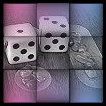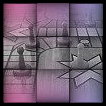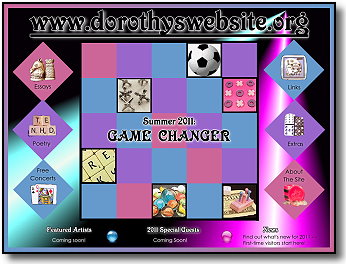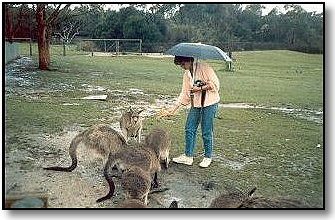 | |||||
|
| |||||
|
* * * * CLICK HERE * |
ABOUT THE SITE
So what about games themselves? How it is that in this day and age, when products arrive on and disappear from store shelves in a matter of weeks or months, some of the games depicted on the site this summer have lasted for hundreds or even thousands of years? Some, like checkers, have survived in mostly the same format for ages, while others, like chess, have endured but have changed and been changed by the world around them. Religious leaders, for example, are considered to have been responsible for moving the Indian game of Chaturanga (considered to be the precursor to chess) in the direction toward the modern game. Since gambling was outlawed at the time in Hindu culture, players dropped the use of dice so as to take away the element of chance and increase the use of tactical skill. In many cases, games also have gone from being the amusements or leisure pursuits of the wealthy or ruling classes to the popular pasttimes of more mass-market audiences. And while in more ancient times games might have taken hundreds of years to travel along trade routes or from continent to continent, today's multi-player online games can connect competitors from virtually anywhere in the world in a matter of seconds. What makes these games - or any games, sport or non-sport - so enduring? In his 2009 book "Cowboys Full: The Story of Poker," author James McManus says: " . . .at the higher symbolic level on which most modern humans also operate, cerebral games like chess, bridge, poker, Scrabble, and what we call trading or handicapping -- betting on the performance of horses, humans, corporations, or currencies -- mimic what scouts, hunting-party leaders, and tribal chiefs used to do and, nowadays, what captains, coaches, CEOs, generals and presidents do. While our physical and mental skill sets are both still evolving, our competitive urge probably feels much the same as it did twelve thousand years ago on the Colorado plateau or Kenyan savanna." You can find a bit more information about the games depicted on the pages of the site on each of the main section pages. You'll find the information at the bottom of the page, and a link to the information is posted in the side column under the news, featured artists and guest link pictures. Hope you enjoy Summer 2011! INTRODUCTION TO WWW.DOROTHYSWEBSITE.ORG/SITE HISTORY The site has its roots in the Cypress College Extended Education computer labs. In 2003, while I was working on a series of computer-based tutorials (covering everything from data warehousing to Linux), I came across tutorials for HTML computer code and the Front Page website design program. As a practice exercise I designed a basic website with the Front Page program and posted it to the internet for about six weeks. Since it contained primarily my works (and a page of concert schedules), I called it www.dorothyswebsite.org. Little did I know then that the six-week exercise would ever have a first, let alone seventh, anniversary! Had I known, perhaps I would have come up with a more "catchy" name. You know what they say about hindsight, though . . . Over the next couple of years I taught myself a bit more of HTML code and website design -- not enough to have a lot of flashy bells and whistles, but enough so that now I do everything for the site. I design it, write the code, research and write the articles and content, take the pictures (and incorporate many from my personal photo archives), compile the listings, manage it, and let you all know that it exists. For those music fans who have found the listings and are new to the site, you will need to know that there are two distinct phases to the site each year. The fall/winter/spring site is mostly text and in a much more succinct three-page format (Concerts By City, Concerts By Date, and an Arts/Special Events page). In the summer, generally from June to September, the site expands and takes on the format which you see now. The main pages of the site have evolved somewhat since 2003, and they are: Poetry: In 1998 I wrote a short volume of poetry based on photographs which I had taken while travelling and living
overseas. The volume was reworked in 2004 and new poems were added. Each year a few poems from the volume have been posted to the site, and in 2005 the works of a Guest Poet were also included for the
first time. When possible, new poems are added to the site each year in conjunction with the year's theme. Essays: Each summer there is a new series of three or four essays on a topic of technology-related
current/consumer interest. The Essay Archives contain all the previous works which have appeared on the site from 2003 - 2010. In addition, the current year's essays
are placed in the essay archives the month after they appear in the "This Month's Essay" section. Free Concerts: This is the most visited section of the site. The listings are for free concerts and music-related
events in Orange County, parts of Los Angeles County, and parts of the Inland Empire. Events in clubs, cafes, bars and similar venues covered elsewhere generally are not included. In the summer,
concerts are listed both by date and by city for the three areas and in total in order to make it easier to find relevant information more quickly. Each year a few more cities and/or venues usually are added, and the cities currently
covered for the summer concert programs are listed on the "Concerts By City" main page. You also will find the main concert calendar on the
"Concerts By Date" main page. In 2010, a new section was added to the concert pages: Concerts by Type of Music, and it is now a permanent
section of the site. Links: This page was added primarily due to requests for more information about the musicians/bands appearing at the concerts.
It includes both links to the cities and venues in which the concerts are held, and to the websites of bands/musicians appearing during the summer (when available). A small section of art and poetry links
is included as well. Extras: The extras page was added in 2005 and offers a few other ideas for things to do or see for free during the
summer months. The page is dynamic and continually being updated, and suggestions for items to be included are appreciated. The page also incorporates the type of information which
appears on the site's Twitter page during the rest of the year. About the Site: You're here now! Two other sections have been added since 2003. The Featured Artists page (2004) and Show of the Week section(2005), which has been found on the "Concerts By Date" main calendar page. Both were added in response to requests for more information about the summer entertainers. "Featured Artists" have a large number of performances over the summer in two or three counties, or, as in the case of a group such as the Long Beach Municipal Band, a number of performances in a particular venue or venues. As a general rule of thumb, and in order to give a wide number of groups the opportunity to appear as "Featured Artists," groups will be included in the section no more than once in a three-year period. "Show of the Week" includes acknowledgements of a wide variety of summer artists, special events, and whenever possible, the individuals, organizations and others who so generously make the shows possible. As a general rule of thumb, artists may be included in this section no more than twice in a three-year period. In 2010, the "Show of the Week" section unfortunately did not appear. You can read more about the section on either the News page or under the main concert calendar on the Concerts By Date page. Website Guests: The works of a guest photographer were included in the site for the first time in 2004. In 2005, the site exhibited works of a guest photographer, guest painter and guest poet. These special guests are invited to exhibit works on the site which, as of 2006, either express or in some way interpret the summer theme. The site is called "www.dorothyswebsite.org," and if you understand a bit about how it has evolved, you'd know why the works on it have been mine. If the site stays in existence, however, my hope is that it will become much less about my materials and much more of a summer exhibition space for the works of other poets, painters, photographers and artists. Eventually this may also include a guest website designer/programmer, but only time will tell . . .
Photograph "Australian Protea" © 1985 Dorothy A. Birsic There is no logo for the site, but if there was, it might include a protea flower like the one shown in the picture above. The word "protean" has its roots in mythology in the god Proteus, a legendary sea god who had the power of assuming different shapes. In its more modern use it describes something capable of great change or readily assuming different shapes or forms. Hopefully this will continue to be a "protean" site in the sense that it can readily adapt to the changing circumstances in which it exists and become an ever more interesting stop for those who take the time to visit. Dorothy holds a bachelor's degree from the University of Southern California. She also designed and completed a graduate program combining an M.B.A. from the Harvard Business School with an M.A.L.D. (Master of Arts in Law and Diplomacy) from the Fletcher School of Law and Diplomacy at Tufts University. She also has taken on additional coursework in Human and Plant Biology, Genetics and Neuroscience. Dorothy's professional background includes work in public relations and management consulting. She has been a Fulbright Scholar in the former Yugoslavia, a Rotary International Scholar/Ambassador in Sydney, Australia, and lived and worked in Japan. She speaks Croatian, has passed oral and written translation exams in Japanese, and is currently teaching herself Spanish. In previous years, there also has been a section on the site featuring excerpts from a variety of Dorothy's personal and professional writings. Please click here to view those excerpts on a new page.
"Dorothy With Kangaroos" Miss Birsic is an avid sports and music fan. She plays tennis, basketball, runs, is a certified PADI diver, bikes, and enjoys photography and playing the piano. She spends a bit of time in the garden, too, tending to everything from lemons and alpine strawberries to passion flower vines and dahlias. If you have any questions or comments about the website, please send e-mail to information@dorothyswebsite.org.
Follow www.dorothyswebsite.org on TWITTER! Home | Essays |
Poetry | Free Concerts | Links | 2011 Extras |
About the Site |
||||
 | |||||
|
www.dorothyswebsite.org © 2003 - 2011 Dorothy A. Birsic. All rights reserved. Comments? Questions? Send an e-mail to: information@dorothyswebsite.org | |||||



 In what has become a commonly-used phrase today, something that is "game-changing" usually refers to that which completely changes the way things are done,
thought about or made. By the very inclusion of the word "game," however, the phrase conjures up the image of a type of organized level of activity: a given arena or field of play, set players, given rules, etc. Also implicit in the phrase are elements of strategy, skill, luck or chance, and how they converge to alter what is
known, accepted or expected.
In what has become a commonly-used phrase today, something that is "game-changing" usually refers to that which completely changes the way things are done,
thought about or made. By the very inclusion of the word "game," however, the phrase conjures up the image of a type of organized level of activity: a given arena or field of play, set players, given rules, etc. Also implicit in the phrase are elements of strategy, skill, luck or chance, and how they converge to alter what is
known, accepted or expected.


